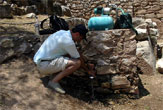New Theory on What Got the Oracle of Delphi High

Something in the ancient Greek temple of Delphi made its priestess high enough to believe she could predict the future. Scientists just can’t agree on what.
In the temple, the resident female oracle, called a Pythia, was a role filled by a succession of women over the years, usually priestesses of high birth who lived a solitary life in the temple.
A simple cocktail of carbon dioxide mixed with methane could have induced the psychic trances that the Pythia used to channel the gods and dish out their advice, according to the latest, Italian-led study.
“It is possible that the toxicity problems [were] due just to a deficit of oxygen in the Temple room, where air ventilation was weak and the gas release from the soil was strong,” said study leader Giuseppe Etiope of the National Institute of Geophysics and Volcanology in Rome.
Etiope’s research refutes the widely-reported 2001 findings of geologist Jelle Z. de Boer, who blamed ethylene escaping from an intersection of faults beneath the temple [image] as the gaseous culprit.
Cryptic ramblings
The Oracle of Delphi was considered one of the most sacred sites in all of ancient Greece from about 1400 BC to 400 AD. It is located 112 miles from Athens. People from all walks of life made pilgrimages there to seek advice from the God Apollo, which was relayed to them by the half-baked Pythia. Her often cryptic ramblings were highly regarded and affected everything from the outcome of wars to when farmers planted their crops.
Sign up for the Live Science daily newsletter now
Get the world’s most fascinating discoveries delivered straight to your inbox.
The Pythia entered her trance by inhaling sweet-smelling noxious fumes coming from deep fissures underneath the temple, according to the ancient historian Plutarch.
A lack of evidence led modern archaeologists to dismiss Plutarch’s observations until traces of ethylene were found in the temple’s stone walls by de Boer, a geologist at Wesleyan University in Connecticut. Ethylene stimulates the central nervous system, causing hallucinations, and emits a sweet odor.
Etiope’s new findings, published in a recent edition of the journal Geology, challenge the popular ethylene theory. “We excluded ethylene as a candidate because it is impossible to have in nature ethylene concentrations so high to induce odour and neurotoxic effects,” Etiope told LiveScience. “This environment is prone to methane formation...the only plausible explanation is that in the past there was a bigger methane emission (with a small amount of carbon dioxide),” he said. Methane was found in spring waters around the site by Etiope and his team.
If the Pythias were drugged by a combination of carbon dioxide and methane, that still does not explain the sweet smell Plutarch described, countered de Boer.
“Oxygen deprivation would not cause a sweet smell, but a nasty odor of the Pythia's stomach contents on the floor,” de Boer said.
Pythias Lived Long and Prospered
Though it has yet to be confirmed by tests, Etiope believes that the sweet odor could have come from traces of benzene, another toxic hydrocarbon found in the area.
It’s an unlikely hypothesis, said de Boer.
“Benzene is a dangerous substance and after a number of sessions the Pythias would have become sick and possibly died,” de Boer said. “Frequent deaths of Pythias have not been reported by any of the classical writers. On the contrary, they seem to have lived a long and healthy life.”
- Parthenon Once a Riot of Color
- Typhoid Fever Behind Fall of Athens
- Land of Homer's 'Odyssey' Said Found
- Greek Shipwreck from 350 BC Revealed
- Palace of Greek Warrior Ajax Said Found
- Massive Eight-Chamber Tomb Found in Greece










